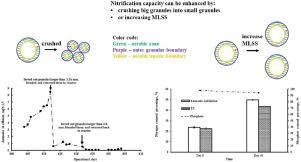Water Research ( IF 12.8 ) Pub Date : 2020-09-25 , DOI: 10.1016/j.watres.2020.116445 Bao Nguyen Quoc , Stephany Wei , Maxwell Armenta , Robert Bucher , Pardi Sukapanpotharam , David A. Stahl , H. David Stensel , Mari-Karoliina H. Winkler

|
The relationship between ammonia oxidation rate, nitrifiers population, and modelled aerobic zone volume in different granule sizes was investigated using aerobic granular sludge from a pilot-scale reactor. The pilot was fed with centrate and secondary effluent amended with acetate as the main carbon source. The maximum specific ammonia oxidation rates and community composition of different aerobic granular sludge size fractions were evaluated by batch tests, quantitative PCR, and genomic analysis. Small (331µm) granules had a 4.72 ± 0.09 times higher maximum specific ammonia oxidizing rate per 1 gVSS, and a 4.05 ± 0.17 times higher specific amoA gene copy number than large (2225µm) granules per 1 gram of wet biomass. However, when related to surface area, small granules had 1.43 ± 0.01 times lower maximum specific ammonia oxidation rate and a 1.66 ± 0.04 times lower specific amoA gene copy number per unit surface than large granules. Experimental results aligned with modeling results in which smaller granules had a higher specific aerobic zone volume to biomass and lower specific aerobic zone volume to surface area. Aerobic granular sludge reactors having the same average diameter of granules may have very different proportions of granule size fractions and hence possess different nitrification rates. Therefore, instead of the commonly reported average granule diameter, a new method was proposed to determine the aerobic volume density per sample, which correlated well with the nitrification rate. This work provides a roadmap to control nitrification capacity by two methods: (a) crushing larger granules into smaller fractions, or (b) increasing the mixed liquor suspended solid concentration to increase the total aerobic zone volume of the system.
中文翻译:

好氧颗粒污泥:粒度分布对硝化能力的影响
使用来自中试规模反应器的好氧颗粒污泥研究了氨氧化速率,硝化剂数量和不同颗粒大小的好氧区域体积之间的关系。向飞行员提供浓缩液,并用乙酸盐作为主要碳源对二级废水进行修正。通过分批测试,定量PCR和基因组分析,评估了不同需氧颗粒污泥大小分数的最大比氨氧化速率和群落组成。小型(331µm)颗粒每1 gVSS的最大比氨氧化速率高4.72±0.09倍,比amoA高4.05±0.17倍每1克湿生物质中的基因拷贝数大于大颗粒(2225μm)。然而,与表面面积时,小颗粒具有1.43±0.01倍降低最大比氨氧化率和1.66±0.04倍降低特定AMOA每单位表面的基因拷贝数要比大颗粒大。实验结果与建模结果一致,在模型化结果中,较小的颗粒具有较高的生物量比需氧区体积和较低的表面积比有氧区体积。具有相同的平均粒径的好氧颗粒污泥反应器可能具有非常不同的颗粒尺寸比例比例,因此具有不同的硝化速率。因此,代替通常报道的平均颗粒直径,提出了一种测定每个样品的需氧量密度的新方法,该方法与硝化率密切相关。这项工作提供了两种方法来控制硝化能力的路线图:(a)将较大的颗粒破碎成较小的部分,



























 京公网安备 11010802027423号
京公网安备 11010802027423号